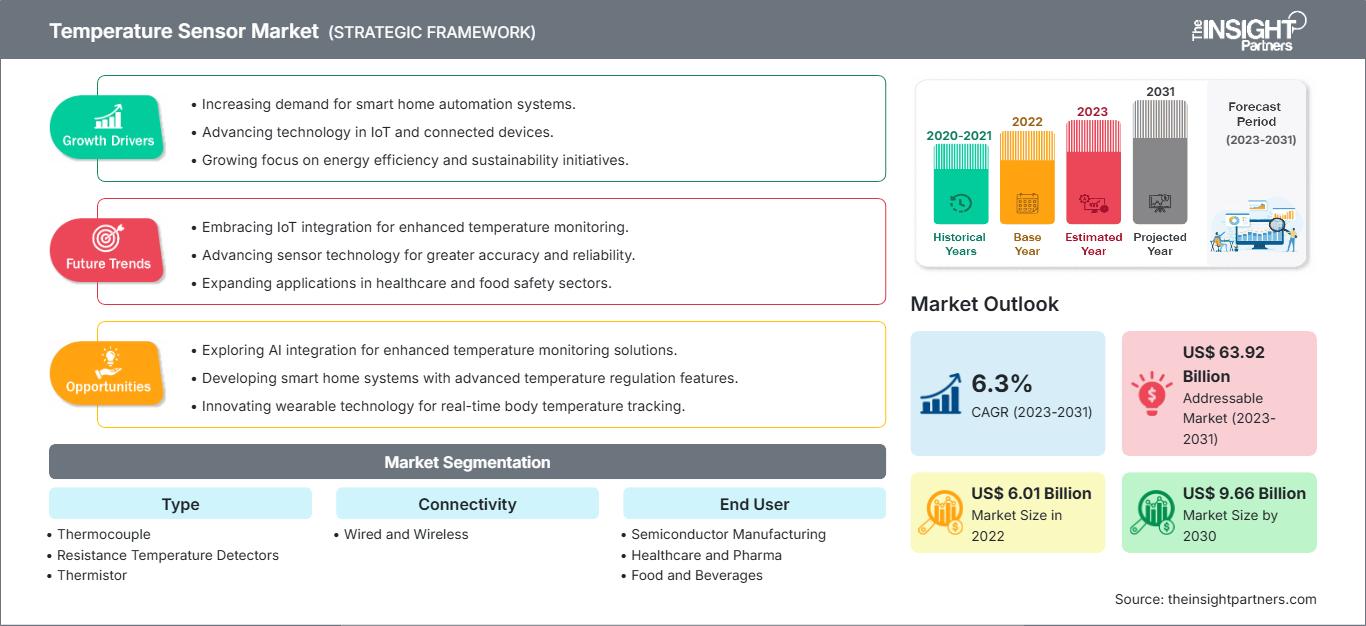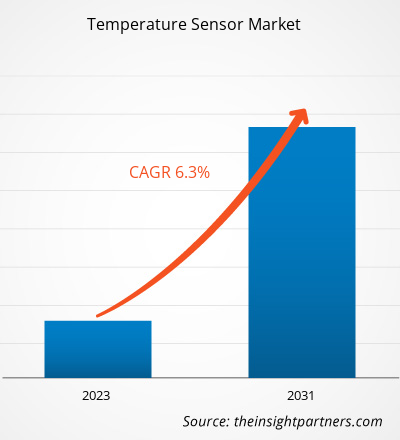预计到 2030 年,温度传感器市场规模将从 2022 年的 60.1 亿美元增至 96.6 亿美元。预计该市场在 2022 年至 2030 年期间的复合年增长率为 6.3%。温度传感器的小型化可能仍将是市场的一个主要趋势。
温度传感器市场分析
全球制造商对温度传感技术的需求不断增长,预计将在预测期内推动温度传感器市场的发展。温度传感技术广泛应用于消费电子、汽车、通信、工业和企业领域。数据中心建设活动数量的增长、可再生能源和智慧城市项目的增加以及政府的重大举措正在推动温度传感器市场的发展。半导体制造、航空航天、医疗保健和制药、食品和饮料、能源和公用事业和数据中心对整个温度传感器市场贡献巨大。
快速的城市化和全球人口的增长推动了半导体制造、消费电子和汽车行业的发展。消费电子行业的扩张,加上对智能手机、平板电脑、笔记本电脑、智能手表和台式电脑日益增长的需求,极大地促进了温度传感器市场的扩张。消费者非常关注维持设备温度并防止设备过热,这反映出对集成到智能手机、智能手表、平板电脑、笔记本电脑和其他消费电子设备中的温度传感器功能的需求很高。热电偶温度传感器高度集成到智能手机和平板电脑中,以防止过热。此外,温度传感器的小型化预计将在未来几年带来新的温度传感器市场趋势。
温度传感器市场概览
温度传感器是一种用于测量和检测液体温度、空气温度或固体物质温度的设备。温度传感器测量物体的冷热程度,并将其转换为计算机或其他监控设备可以读取的电信号。市面上有各种各样的温度传感器,例如热电偶、热敏电阻、电阻式温度检测器和红外线。它们采用不同的原理和技术来测量不同的温度。消费者使用的多种产品都严重依赖温度传感器。冰箱、微波炉、恒温器和烤箱等消费电子设备的正常运行依赖于温度控制和维护。
自定义此报告以满足您的要求
您将免费获得任何报告的定制,包括本报告的部分内容,或国家级分析、Excel 数据包,以及为初创企业和大学提供超值优惠和折扣
温度传感器市场: 战略洞察

-
获取本报告的主要市场趋势。这个免费样本将包括数据分析,从市场趋势到估计和预测。
温度传感器市场驱动因素和机遇
各行各业的日益普及有利于市场
温度传感器用于半导体制造、航空航天、医疗保健和制药、食品和饮料、能源和公用事业以及数据中心等领域的各种用途,用于准确有效地监测特定物体或环境的温度。这些传感器用于计算特定物体或环境的温度。下面提到的是温度传感器在众多行业中的用途和优势。
- 半导体制造 - 温度传感器通常集成在集成电路 (IC) 中,包括微处理器和微控制器。这些 IC 广泛用于制造笔记本电脑、平板电脑、台式电脑、移动电话和其他电子设备。电子制造商对高性能微处理器和微控制器的需求不断增长。
- 航空航天 -温度传感器对于航空航天工业至关重要,用于测量液压油、燃油和冷却液的温度。电阻温度检测器 (RTD) 和热电偶是两种最常见的温度传感器,它们能够承受极端高温环境,并用于精确测量发动机的过载。
食品饮料、能源公用事业、数据中心、石油天然气、采矿业和汽车等其他行业也越来越多地采用温度传感器来测量发动机和机器的温度。温度传感器的日益普及有助于各行各业通过跟踪活动来测量温度,这反过来又有利于温度传感器市场的增长。
无线温度传感器需求不断增长
无线温度传感器是一种配备发射器的测量设备,使过程控制仪表能够通过无线电传输信号。接收器解读无线电信号后,将其转换为所需的输出,例如模拟电流或通过计算机软件进行数据分析。技术进步和对远程监控设备日益增长的需求,正在推动各行各业对无线温度传感器的需求。无线温度传感器需求的不断增长与各行各业对物联网 (IoT) 技术的日益依赖息息相关。无线温度传感器提供无与伦比的可扩展性和灵活性,并支持在偏远地区部署。无线温度传感器的这种灵活性和可扩展性还扩展到用于监测特定环境的临时装置,例如易腐货物储存和运输过程中的温度波动。因此,预计所有这些因素在预测期内都将对市场有利。
温度传感器市场报告细分分析
促成温度传感器市场分析的关键细分领域包括类型、连接性和最终用户。
- 根据类型,温度传感器市场分为热电偶、电阻温度检测器 (RTD)、热敏电阻、红外线和其他类型。热电偶细分市场将在 2022 年占据相当大的市场份额。
- 根据连接性,市场分为有线和无线。 2022 年,有线细分市场占有最大的市场份额。
- 就最终用户而言,市场细分为半导体制造、医疗保健和制药、食品和饮料、数据中心、航空航天、能源和公用事业等。2022 年,半导体制造细分市场占有最大的市场份额。
按地域划分的温度传感器市场份额分析
温度传感器市场报告的地理范围主要分为五个区域:北美、亚太地区、欧洲、中东和非洲以及南美和中美洲。
2022 年,亚太地区在温度传感器市场占有最大的市场份额。多年来,多个亚洲行业,尤其是半导体制造、汽车、消费电子、数据中心和能源,对温度传感器的需求迅速增长。据亚太基金会称,中国大陆和台湾大幅增加了对芯片制造的投资,韩国和日本也希望从中受益。任何芯片的制造都需要沉积、光刻胶、光刻、电离、硅片和封装等众多工艺流程。这些工艺流程中使用温度传感器来测量和监测温度,这进一步推动了市场的增长。此外,台湾半导体制造公司计划在日本设立其首家工厂,这与日本首相优先发展半导体制造以扩大国内供应链的议程相一致。
温度传感器市场区域洞察
The Insight Partners 的分析师已详尽阐述了预测期内影响温度传感器市场的区域趋势和因素。本节还讨论了北美、欧洲、亚太地区、中东和非洲以及南美和中美洲的温度传感器市场细分和地域分布。
温度传感器市场报告范围
| 报告属性 | 细节 |
|---|---|
| 市场规模 2022 | US$ 6.01 Billion |
| 市场规模 2030 | US$ 9.66 Billion |
| 全球复合年增长率 (2023 - 2031) | 6.3% |
| 历史数据 | 2020-2021 |
| 预测期 | 2023-2031 |
| 涵盖的领域 |
By 类型
|
| 覆盖地区和国家 |
北美
|
| 市场领导者和主要公司简介 |
|
温度传感器市场参与者密度:了解其对业务动态的影响
温度传感器市场正在快速增长,这得益于终端用户需求的不断增长,而这些需求的驱动因素包括消费者偏好的不断变化、技术进步以及对产品优势的认知度不断提高。随着需求的增长,企业正在扩展产品线,不断创新以满足消费者需求,并抓住新兴趋势,从而进一步推动市场增长。

- 获取 温度传感器市场 主要参与者概述
温度传感器市场新闻及最新发展
温度传感器市场的评估是通过收集一手和二手研究的定性和定量数据进行的,这些数据包括重要的公司出版物、协会数据和数据库。温度传感器市场的一些发展如下:
- Microchip Technology Inc. 推出了 MCP998x 系列,该系列包含 10 款符合汽车标准的远程温度传感器。MCP998x 系列设计用于在宽工作温度范围内实现 1°C 的精度,是业内最大的汽车级多通道温度传感器产品组合之一。它包含五个具有关断温度设定点的传感器,这些设定点的设计不会被软件覆盖或恶意禁用。(来源:Microchip Technology Inc.,新闻稿,2023 年 7 月)
- TDK 公司推出了 TDK i3 微型模块,这是首款具有边缘 AI 和无线网状连接功能的模块。它是与德州仪器 (TI) 合作开发的。它集成了 TI SimpleLink、Arm Cortex-M4F MCU、SmartIndustrial MEMS 加速度计和网状网络功能。该模块简化了部署和传感器数据收集。(来源:TDK 公司,新闻稿,2023 年 1 月)
温度传感器市场报告覆盖范围和交付成果
“温度传感器市场规模及预测(2020-2030 年)”报告提供了涵盖以下领域的市场详细分析:
- 温度传感器市场规模以及涵盖范围内所有主要细分市场的全球、区域和国家/地区预测
- 温度传感器市场趋势以及市场动态,例如驱动因素、限制因素和关键机遇
- 详细的 PEST/Porter 五力模型和 SWOT 分析
- 温度传感器市场分析涵盖主要市场趋势、全球和区域框架、主要参与者、法规和最新市场发展
- 行业格局和竞争分析涵盖市场集中度、热图分析、知名参与者和温度传感器市场的最新发展
- 详细的公司简介
- 历史分析(2 年)、基准年、预测(7 年)及复合年增长率
- PEST和SWOT分析
- 市场规模、价值/数量 - 全球、区域、国家
- 行业和竞争格局
- Excel 数据集
近期报告
相关报告
客户评价
购买理由
- 明智的决策
- 了解市场动态
- 竞争分析
- 客户洞察
- 市场预测
- 风险规避
- 战略规划
- 投资论证
- 识别新兴市场
- 优化营销策略
- 提升运营效率
- 顺应监管趋势






















 获取免费样品 - 温度传感器市场
获取免费样品 - 温度传感器市场